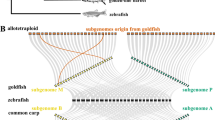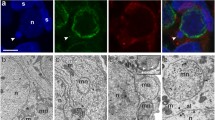Abstract
Polyploidy has played a most important role in speciation and evolution of plants and animals. It is thought that low frequency of polyploidy in mammals is due to a dosage imbalance that would interfere with proper development in mammalian polyploids. The first tetraploid mammal, Tympanoctomys barrerae (Octodontidae), appears to be an exception to this rule. In this study we investigated X chromosome inactivation (XCI) and genomic imprinting in T. barrerae, two epigenetic processes usually involved in dosage control in mammalian genomes. The imprinting status of the Peg1 gene was determined by Peg1 allelic expression studies. The inactive X chromosome was identified on interphase nuclei by immunofluorescence using specific antisera raised against Met3H3K27 and macroH2A1. Quantitative PCR was used to compare the Peg1/Dmd ratio in T. barrerae and in its most closely related diploid species, Octomys mimax. Our data demonstrate that parental-specific silencing of at least one gene and normal X chromosomal dosage mechanism are conserved in the tetraploid genome. We hypothesize a concerted action of genetic and epigenetic mechanisms during the process of functional diploidization of this tetraploid genome.




Similar content being viewed by others
References
Adams KL, Wendel JF (2005) Novel patterns of gene expression in polyploid plants. Trends Genet 21:539–543
Adams KL, Cronn R, Percifield R, Wendel JF (2003) Genes duplicated by polyploidy show unequal contributions to the transcriptome and organ-specific reciprocal silencing. Proc Natl Acad Sci USA 100:4649–4654
Birchler JA, Riddle NC, Auger DL, Veitia RA (2005) Dosage balance in gene regulation: biological implications. Trends Genet 21:219–226
Boggs BA, Cheung P, Heard E, Spector DL, Chinault AC et al (2002) Differentially methylated forms of histone H3 show unique association patterns with inactive human X chromosomes. Nat Genet 30:73–76
Chadwick BP, Willard HF (2003) Chromatin of the Barr body: histone and non-histone proteins associated with or excluded from the inactive X chromosome. Hum Mol Genet 12:2167–2178
Comai L (2005) The advantages and disadvantages of being polyploid. Nat Rev Genet 6:836–846
Duvillie B, Bucchini D, Tang T, Jami J, Paldi A (1998) Imprinting at the mouse Ins2 locus: evidence for cis- and trans-allelic interactions. Genomics 47:52–57
Eakin GS, Behringer RR (2003) Tetraploid development in the mouse. Dev Dyn 228:751–766
Gallardo MH, Bickham JW, Honeycutt RL, Ojeda RA, Köhler N (1999) Discovery of tetraploidy in a mammal. Nature 401:341
Gallardo MC, Krisch J (2001) Molecular relationships among Octodontidae (Mammalia: Rodentia: Caviomorpha). J Mamm Evol 8:73–89
Gallardo MH, Garrido O, Bahamonde R, Gonzalez M (2004a) Gametogenesis and nucleotypic effects in the tetraploid red vizcacha rat, Tympanoctomys barrerae (Rodentia, Octodontidae). Biol Res 37:767–775
Gallardo MH, Kausel G, Jiménez A, Bacquet C, González C et al (2004b) Biol J Linnean Soc 82:443–451
Gallardo MH, González C, Cebrian I (2006) Molecular cytogenetics and allotetraploidy in the red vizcacha rat, Tympanoctomys barrerae (Rodentia, Octodontidae). Genomics 88:214–221
Gallardo MH, Ojeda RA, Gonzalez CA, Rios CA (2007) The Octodontidae revisited. Univ Calif Publ Zool 134:695–719
Goto T, Monk M (1998) Regulation of X-chromosome inactivation in development in mice and humans. Microbiol Mol Biol Rev 62:362–378
Guc-Scekic M, Milasin J, Stevanovic M, Stojanov L, Djordjevic M (2002) Tetraploidy in a 26-month-old girl (cytogenetic and molecular studies). Clin Genet 61:62–65
Hall T (2001) Bioedit version 5.0.6. Department of Microbiology, North Carolina State University http://www.mbio.ncsu.edu/BioEdit/bioedit.html
Heard E, Rougeulle C, Arnaud D, Avner P, Allis CD et al (2001) Methylation of histone H3 at Lys-9 is an early mark on the X chromosome during X inactivation. Cell 107:727–738
Kaneko-Ishino T, Kuroiwa Y, Miyoshi N, Kohda T, Suzuki R et al (1995) Peg1/Mest imprinted gene on chromosome 6 identified by cDNA subtraction hybridization. Nat Genet 11:52–59
LaSalle J, Lalande M (1996) Homologous association of oppositely imprinted chromosomal domains. Science 272:725–728
Lefebvre L, Viville S, Barton SC, Ishino F, Surani MA (1997) Genomic structure and parent-of-origin-specific methylation of Peg1. Hum Mol Genet 6:1907–1915
Liu B, Wendel JF (2003) Epigenetic phenomena and the evolution of plant allopolyploids. Mol Phylogenet Evol 29:365–379
Mermoud JE, Costanzi C, Pehrson JR, Brockdorff N (1999) Histone macroH2A1.2 relocates to the inactive X chromosome after initiation and propagation of X-inactivation. J Cell Biol 147:1399–1408
Nishita Y, Yoshida I, Sado T, Takagi N (1996) Genomic imprinting and chromosomal localization of the human MEST gene. Genomics 36:539–542
Ohlsson R, Paldi A, Graves J (2001) Did genomic imprinting and X chromosome inactivation arise from stochastic expression? Trends Genet 17:136–142
Paldi A (2003) Genomic imprinting: could the chromatin structure be the driving force? Curr Top Dev Biol 53:115–138
Paldi A, Jouvenot Y (1999) Allelic trans-sensing and imprinting. Results Probl Cell Differ 25:271–282
Pardo-Manuel de Villena F, de la Casa-Esperon E, Sapienza C (2000) Natural selection and the function of genome imprinting: beyond the silenced minority. Trends Genet 16:573–579
Park Y, Kuroda M (2001) Epigenetic aspects of X-chromosome dosage compensation. Science 293:1083–1085
Plath K, Mlynarczyk-Evans S, Nusinow DA, Panning B (2002) Xist RNA and the mechanism of X chromosome inactivation. Annu Rev Genet 36:233–278
Plath K, Fang J, Mlynarczyk-Evans SK, Cao R, Worringer KA et al (2003) Role of histone H3 lysine 27 methylation in X inactivation. Science 300:131–135
Pozzoli U, Elgar G, Cagliani R, Riva L, Comi GP et al (2003) Comparative analysis of vertebrate dystrophin loci indicate intron gigantism as a common feature. Genome Res 13:764–772
Reule M, Krause R, Hemberger M, Fundele R (1998) Analysis of Peg1/Mest imprinting in the mouse. Dev Genes Evol 208:161–163
Roberts RG, Bobrow M (1998) Dystrophins in vertebrates and invertebrates. Hum Mol Genet 7:589–595
Rougeulle C, Chaumeil J, Sarma K, Allis CD, Reinberg D et al (2004) Differential histone H3 Lys-9 and Lys-27 methylation profiles on the X chromosome. Mol Cell Biol 24:5475–5484
Sambrook J, Frisch E, Maniatis T (1989) Molecular cloning: a laboratory manual, 2nd edn. Cold Spring Harbor Laboratory Press
Shi W, Lefebvre L, Yu Y, Otto S, Krella A et al (2004) Loss-of-imprinting of Peg1 in mouse interspecies hybrids is correlated with altered growth. Genesis 39:65–72
Svartman M, Stone G, Stanyon R (2005) Molecular cytogenetics discards polyploidy in mammals. Genomics 85:425–430
Veitia RA (2005) Paralogs in polyploids: one for all and all for one? Plant Cell 17:4–11
Vrana P, Guan X, Ingram R, Tilghman S (1998) Genomic imprinting is disrupted in interspecific Peromyscus hybrids. Nat Genet 20:362–365
Vrana PB, Fossella JA, Matteson P, del Río T, O’Neill MJ et al (2000) Genetic and epigenetic incompatibilities underlie hybrid dysgenesis in Peromyscus. Nat Genet 25:120–124
Wendel JF (2000) Genome evolution in polyploids. Plant Mol Biol 42:225–249
Acknowledgments
The work was supported by Fondo Nacional de Ciencias (Chile), grants FNC 1010727 and 1070217 to MHG, a French government PhD fellowship (CB), a travel fellowship ECOS-Conicyt grant C01B02, and Genethon. The authors thank Dr. Edith Heard for the macroH2A1 antibodies.
Author information
Authors and Affiliations
Corresponding author
Rights and permissions
About this article
Cite this article
Bacquet, C., Imamura, T., Gonzalez, C.A. et al. Epigenetic processes in a tetraploid mammal. Mamm Genome 19, 439–447 (2008). https://doi.org/10.1007/s00335-008-9131-z
Received:
Accepted:
Published:
Issue Date:
DOI: https://doi.org/10.1007/s00335-008-9131-z




